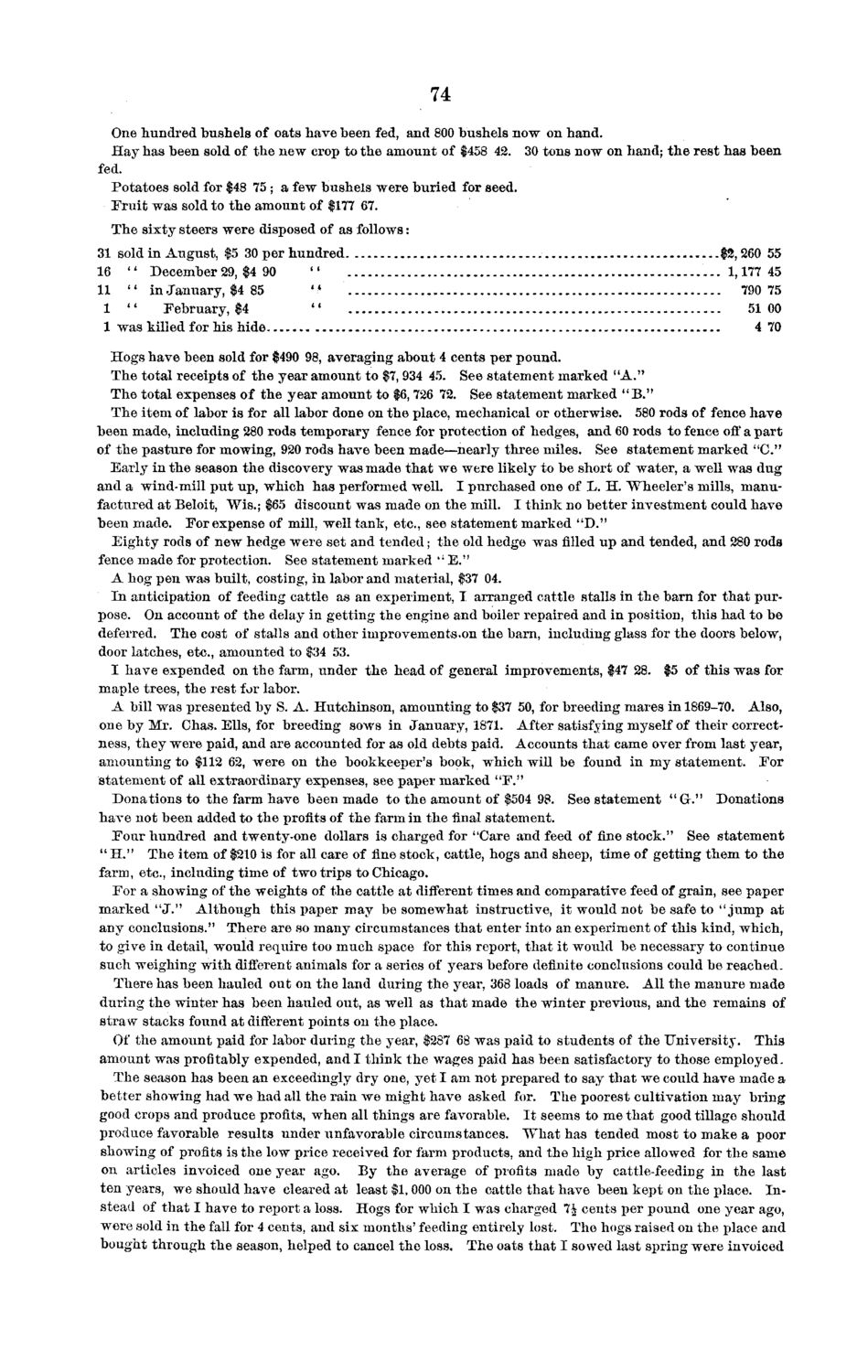| |
| |
Caption: Board of Trustees Minutes - 1872
This is a reduced-resolution page image for fast online browsing.

EXTRACTED TEXT FROM PAGE:
74 One hundred bushels of oats have been fed, and 800 bushels now on hand. Hay has been sold of the new crop to the amount of $458 42. 30 tons now on hand; the rest has been fed. Potatoes sold for $48 75 ; a few bushels were buried for seed. Fruit was sold to the amount of $177 67. The sixty steers were disposed of as follows: 31 sold in August, $5 30 per hundred 16 " December 29, $4 90 " 11 " in January, $4 85 '« 1 " February, $4 " 1 was killed for his hide $2,260 55 ...1,177 45 790 75 5100 4 70 Hogs have been sold for $490 98, averaging about 4 cents per pound. The total receipts of the year amount to $7, 934 45. See statement marked "A." The total expenses of the year amount to $6, 726 72. See statement marked " B . " The item of labor is for all labor done on the place, mechanical or otherwise. 580 rods of fence have been made, including 280 rods temporary fence for protection of hedges, and 60 rods to fence off a part of the pasture for mowing, 920 rods have been made—nearly three miles. See statement marked "C." Early in the season the discovery was made that we were likely to be short of water, a well was dug and a wind-mill put up, which has performed well. I purchased one of L. H. Wheeler's mills, manufactured at Beloit, Wis.; $65 discount was made on the mill. I think no better investment could have been made. For expense of mill, well tank, etc., see statement marked "D." Eighty rods of new hedge were set and tended; the old hedge was filled up and tended, and 280 rods fence made for protection. See statement marked " E." A hog pen was built, costing, in labor and material, $37 04. In anticipation of feeding cattle as an experiment, I arranged cattle stalls in the barn for that purpose. On account of the delay in getting the engine and boiler repaired and in position, this had to be deferred. The cost of stalls and other improvements.on the barn, including glass for the doors below, door latches, etc., amounted to $34 53. I have expended on the farm, under the head of general improvements, $47 28. $5 of this was for maple trees, the rest for labor. A bill was presented by S. A. Hutchinson, amounting to $37 50, for breeding mares in 1869-70. Also, one by Mr. Chas. Ells, for breeding sows in January, 1871. After satisfying myself of their correctness, they were paid, and are accounted for as old debts paid. Accounts that came over from last year, amounting to $112 62, were on the bookkeeper's book, which will be found in my statement. For statement of all extraordinary expenses, see paper marked " F . " Donations to the farm have been made to the amount of $504 98. See statement " G . " Donations have not been added to the profits of the farm in the final statement. Four hundred and twenty-one dollars is charged for "Care and feed of fine stock." See statement " H." The item of $210 is for all care of fine stock, cattle, hogs and sheep, time of getting them to the farm, etc., including time of two trips to Chicago. For a showing of the weights of the cattle at different times and comparative feed of grain, see paper marked "J." Although this paper may be somewhat instructive, it would not be safe to "jump at any conclusions." There are so many circumstances that enter into an experiment of this kind, which, to give in detail, would require too much space for this report, that it would be necessary to continue such weighing with different animals for a series of years before definite conclusions could be reached. There has been hauled out on the land during the year, 368 loads of manure. All the manure made during the winter has been hauled out, as well as that made the winter previous, and the remains of straw stacks found at different points on the place. Of the amount paid for labor during the year, $287 68 was paid to students of the University. This amount was profitably expended, and I think the wages paid has been satisfactory to those employed. The season has been an exceedingly dry one, yet I am not prepared to say that we could have made a better showing had we had all the rain we might have asked for. The poorest cultivation may bring good crops and produce profits, when all things are favorable. I t seems to me that good tillage should produce favorable results under unfavorable circumstances. What has tended most to make a poor showing of profits is the low price received for farm products, and the high price allowed for the same on articles invoiced one year ago. By the average of profits made by cattle-feeding in the last ten years, we should have cleared at least $1, 000 on the cattle that have been kept on the place. Instead of that I have to report a loss. Hogs for which I was charged 7t cents per pound one year ago, were sold in the fall for 4 cents, and six months' feeding entirely lost. The hogs raised on the place and bought through the season, helped to cancel the loss. The oats that I sowed last spring were invoiced
| |